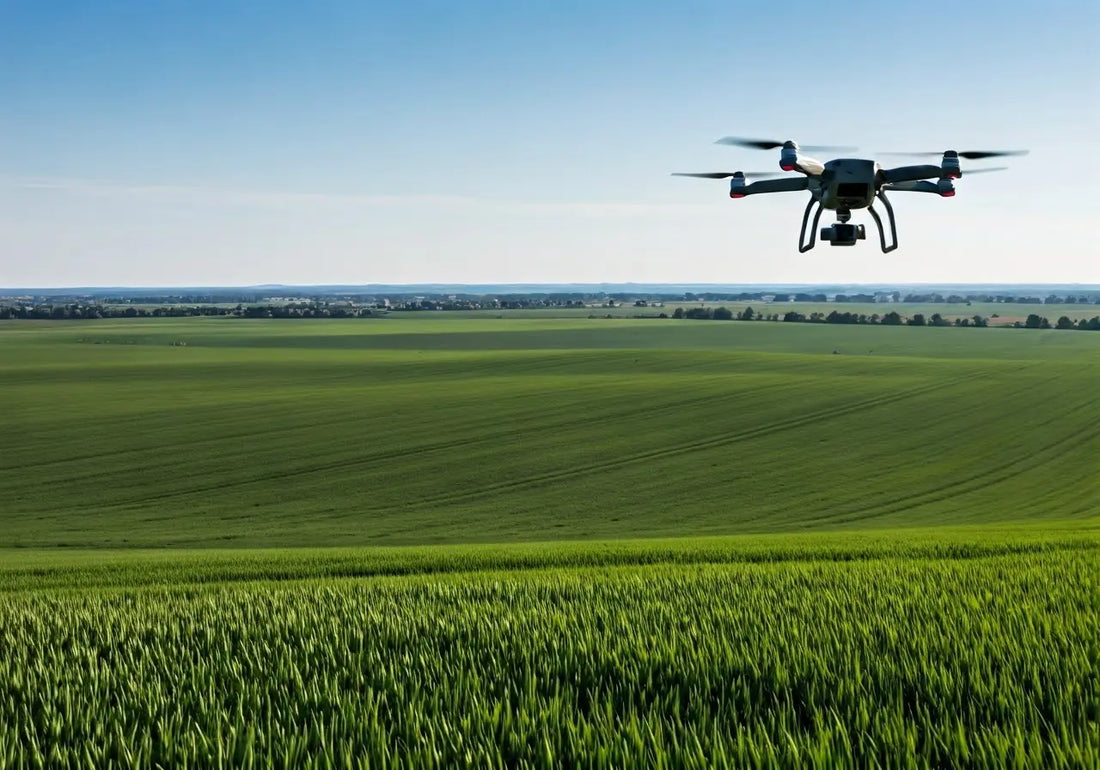
10 Ways Precision Agriculture Drones are Revolutionizing Farming
Share
Precision agriculture drones are quickly transforming the farming industry, making operations more efficient and productive. In this listicle, we’ll explore how these advanced technologies are changing the face of agriculture, one innovative method at a time.
1. Enhancing Crop Monitoring
Drones equipped with advanced sensors allow farmers to monitor crop growth and health more efficiently than traditional methods. Unlike older practices, which often relied on manual inspections and satellite images that could only be taken a few times a day, drones offer real-time monitoring. This means farmers can get instant, detailed images of their crops showing the development and identifying any issues early. By using drones, farmers can create time-series animations that reveal changes in their fields, making it easier to spot inefficiencies in production and improve crop management.
One of the key advantages of using drones for crop monitoring is the ability to capture high-resolution images that provide precise data about the crops. Drones equipped with multispectral sensors can detect subtle variations in crop health that are invisible to the naked eye. For instance, multispectral imaging helps farmers understand plant conditions better, identify stressed plants, and predict yields more accurately. This advanced imaging technique allows for a more proactive approach to crop management, ensuring that issues are addressed before they become significant problems.
By flying closer to the crops compared to satellites, drones offer a much higher resolution of images, providing more accurate and timely information. This aspect is crucial, especially when dealing with large fields where manually inspecting every corner is not practical. Plus, drones’ ability to fly over the same spot multiple times a day means they can track changes and growth patterns that other methods miss. The use of UAVs (Unmanned Aerial Vehicles) not only saves time but also provides a detailed and consistent overview of the crop health, which is invaluable in modern agriculture.
2. Streamlining Irrigation Management
With precise data on soil moisture levels, drones help optimize irrigation schedules, ensuring crops get just the right amount of water. Instead of relying on guesswork or generalized schedules, farmers can use drones equipped with thermal and multispectral sensors to identify which areas of their fields are too dry or too wet. This data allows for targeted watering, which reduces water usage and ensures that each plant gets exactly what it needs to thrive.
For example, drones can fly over a field and use hyperspectral imaging to create detailed maps showing variances in soil and plant moisture levels. This technology helps farmers identify specific areas that need more or less water, rather than applying the same amount across the entire field. By tailoring irrigation efforts to real-time data, farmers can significantly improve water use efficiency, enhancing crop yields and promoting sustainability.
In regions where water scarcity is a critical concern, the use of drones for irrigation management is particularly beneficial. Drones can help conserve water by detecting leaks in irrigation systems and ensuring that watering is done at optimal times to minimize evaporation losses. Furthermore, using drones for irrigation monitoring can reduce the need for labor-intensive inspections, allowing farmers to focus on other essential aspects of farm management.
3. Improving Soil Health Analysis
Drones play an essential role not only in monitoring crops but also in improving soil health analysis. They can collect soil samples and provide detailed analysis, allowing farmers to address specific soil health issues promptly. For instance, multispectral sensors on drones can gather data that reveals variations in soil composition and nutrient levels, which are crucial for determining the right type and amount of fertilizers needed for different parts of the field.
Using drones for soil health analysis also means that farmers can obtain data quickly and efficiently. Instead of waiting for laboratory results, they can get real-time feedback and make informed decisions on the spot. This rapid analysis capability is particularly useful during critical planting and growing stages when timely interventions can make a significant difference in crop performance. As highlighted by Zhejiang Nianifa Agricultural Development, innovations in drone technology are making better planting decisions and improving crop yield through more precise soil and plant data collection.
4. Efficient Pest and Disease Control
By identifying pest infestations and disease outbreaks early, drones help farmers take timely action, minimizing crop damage. The ability to detect issues before they become widespread is crucial in preventing significant losses. Drones equipped with high-resolution cameras and multispectral sensors can capture detailed images that reveal signs of pest activity or disease that might be missed during manual inspections. This early detection allows for targeted treatments, reducing the need for broad-spectrum pesticide applications.
Moreover, drones enable farmers to implement more precise pest control strategies that are both effective and environmentally friendly. By using drones to apply pesticides only where needed, farmers can reduce chemical use, which benefits the environment and promotes sustainability. The efficiency of drone pest control is further enhanced by the ability to cover large areas quickly and access difficult terrain that traditional machinery might struggle with.
5. Enhancing Planting Accuracy
Drones are capable of mapping fields with high precision, aiding in accurate planting and reducing seed wastage. Advanced GPS and mapping technologies enable drones to create detailed field maps that guide planting equipment, ensuring seeds are placed at optimal depths and spacing. This precision planting reduces the likelihood of overcrowding or gaps, leading to more uniform crop stands and better yields.
Implementing drone-based planting systems, such as those developed by Zhejiang Jizhi New Energy Vehicle Technology, showcases the potential of drones in farming. These systems use drones to collect data about the field and help develop a planting plan, which is then executed with the aid of artificial intelligence and automated planting mechanisms. This innovative approach not only enhances planting accuracy but also improves overall efficiency and productivity.
6. Promoting Sustainable Farming
With precise data on resource use, drones support sustainable farming practices by reducing the overuse of water, fertilizers, and pesticides. By targeting specific areas that need treatment, drones help conserve resources and minimize environmental impact. This precision approach aligns with the principles of sustainable farming, which aim to produce food in a way that preserves the ecosystem and supports long-term agricultural viability.
The use of drones for pesticide spraying is a prime example of how technology can promote sustainability in agriculture. Drones can apply pesticides with pinpoint accuracy, reducing chemical runoff and protecting soil and water resources. Additionally, by using drones to monitor crop health and identify issues early, farmers can take timely action to prevent crop losses, thereby enhancing food security and reducing waste.
7. Aiding in Yield Prediction
Advanced imaging techniques help drones provide accurate yield predictions, aiding farmers in their planning and sales strategies. By analyzing data collected from drones, farmers can estimate potential yields and adjust their management practices accordingly. This information is invaluable for making informed decisions about planting, harvesting, and marketing crops.
Drones equipped with multispectral sensors can assess crop health and growth patterns, providing detailed insights into factors that influence yield. By combining this data with historical records and weather patterns, farmers can create more accurate yield forecasts. This proactive approach helps farmers plan better, reducing uncertainties and ensuring that resources are used efficiently.
8. Supporting Livestock Management
Drones are not just for crops. They can also monitor livestock, tracking their movements and ensuring their wellbeing. By providing a bird’s-eye view of large grazing areas, drones help farmers keep an eye on their animals without the need for labor-intensive ground inspections. This capability is particularly useful in extensive farming operations where livestock roam over vast areas.
Equipped with thermal imaging, drones can detect body temperatures and identify animals that might be unwell or injured. This early detection allows farmers to take prompt action, ensuring the health and productivity of their livestock. In addition to health monitoring, drones can also help manage grazing patterns by identifying areas with sufficient fodder and ensuring that livestock are evenly distributed across the pasture.
9. Enhancing Data Collection and Analysis
Drones collect a wealth of data that can be analyzed to make informed decisions, ultimately improving farm management practices. By capturing detailed images and multispectral data, drones provide valuable information on soil health, crop growth, and environmental conditions. This data-driven approach allows farmers to tailor their practices to the specific needs of their fields, increasing efficiency and productivity.
The integration of drones with GIS (Geographic Information Systems) software further enhances data analysis capabilities. For instance, DJI Terra mapping software allows farmers to create accurate 2D and 3D models of their fields, providing a comprehensive overview of their farm. This technology helps farmers make more informed decisions about planting, irrigation, and pest control, leading to better outcomes and higher yields.
10. Improving Safety on Farms
By performing dangerous tasks such as inspecting equipment and buildings, drones enhance safety for farmers and workers. Instead of climbing onto roofs or entering confined spaces, farmers can use drones to conduct visual inspections and identify potential issues from a safe distance. This reduces the risk of accidents and ensures that necessary repairs and maintenance are carried out promptly.
Drones equipped with thermal imaging cameras can also detect heat anomalies in machinery, preventing potential failures and fires. Additionally, drones can monitor farm boundaries and detect intrusions, providing an added layer of security. By taking on these high-risk tasks, drones help create a safer working environment and allow farmers to focus on other critical aspects of their operations.

